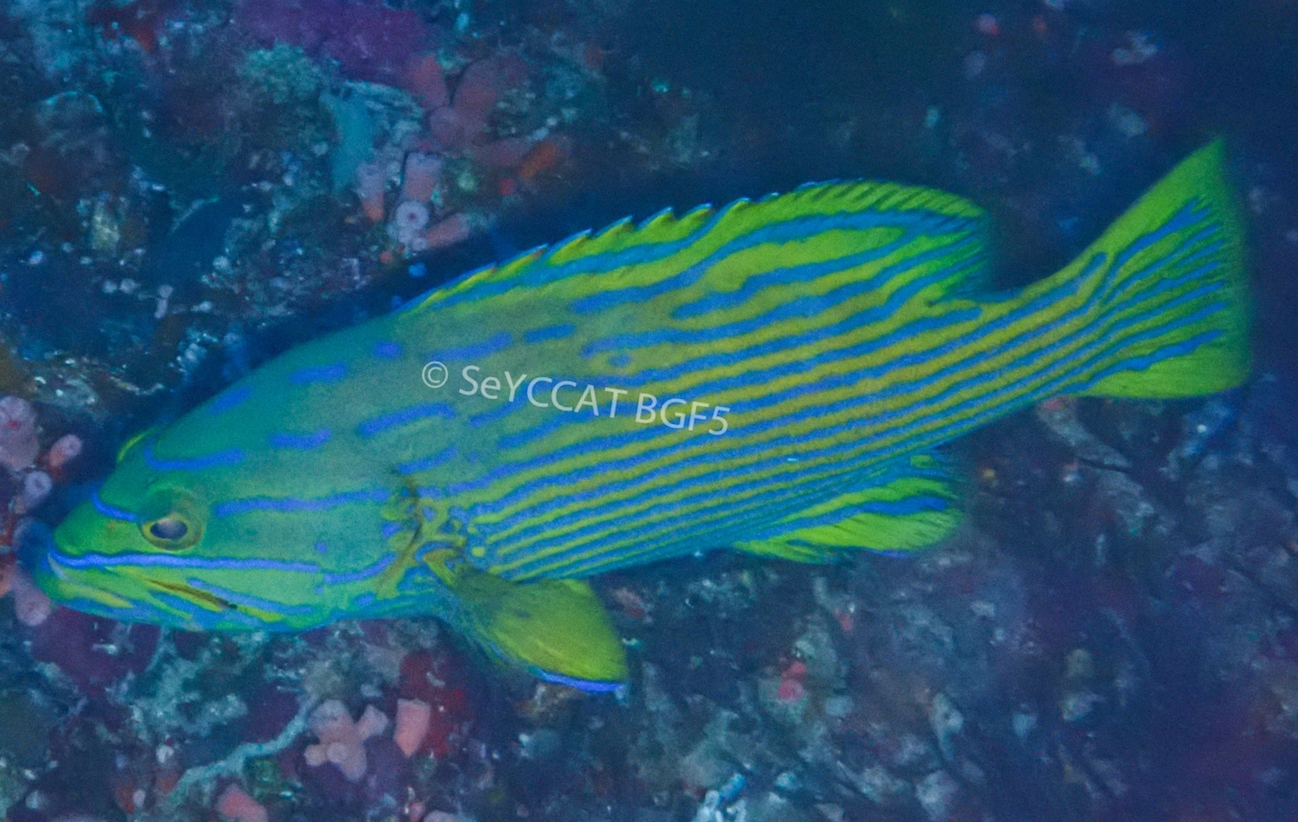Description:
Dorsal spines: 9; Dorsal rays: 14-16; Anal spines: 3; Anal rays: 8-9.
Medium-sized, moderately full-bodied and distinctively coloured grouper. Maxilla reaches approximately to vertical at rear edge of eye. Preopercle rounded
and finely serrate, the lower edge with 1 to 3 broad serra. Lateral body scales ctenoid. Membranes between dorsal fin spines incised. Caudal fin truncate
to slightly emarginate.
Colour.
Adults base colour yellow with 10-12 bright blue or violet horizontal stripes on the body. The upper 2 or 3 stripes are broken into segments anteriorly
and posteriorly extend onto the dorsal fin. Flank stripes that run onto the caudal peduncle bifurcate and continue onto the caudal fin almost to the
posterior margin. Head has 3-6 horizontal blue stripes and exhibits dark brown maxillary streak. Pelvic fins yellow with blue stripes.
Small juveniles (4 cm SL) have yellow snout with large black spot on each side in front of the nostrils. Body is yellowish brown shading to lavendar
ventrally and to yellow at base of caudal fin contining as yellow bands on caudal lobes.
Larger juveniles (10 cm SL) brownish orange with longitudinal purple stripes on the head and body.
Size:
Maturity: Unknown, range 25 - ? cm. Max length : 43.0 cm TL.
Habitat and Ecology:
Widespread, deep living (10 - 120m, rarely seen shallower than 30m, and considered likely to occur deeper than 120 m) reef associated species, occurring
mostly around oceanic islands. Solitary and thought to occur naturally in low population densities. Inhabits clear steep drop-offs. Also found in caves
and crevices where it often swims upside-down against the ceiling of the structure. Feeds on fishes and crustaceans.
Fishery Status:
This species is not protected or subject to fishery regulations. It does not appear to be subject to the artisanal fishery.
Notes:
New species record for Seychelles - Alphonse 2022.
Photo'd and identified by Eleanor Brighton and Chris Mason-Parker (c) 2022 Blue Safari Seychelles/Marine Conservation Society, Seychelles.
Photograph taken at Alphonse group 2022.
References:
Bray, D.J. (2023). Cephalopholis polleni in Fishes of Australia, https://fishesofaustralia.net.au/home/species/5007 (30/05/23).
Craig, M.T. (2018). Cephalopholis polleni. The IUCN Red List 2018: https://dx.doi.org/10.2305/IUCN.UK.2018-2.RLTS.T132805A100457007.en. (30/05/23).
Craig, M.T. et al. (2011). Groupers of the World - a field and market guide. NISC (Pty) Ltd, South Africa. ISBN: 978-1-920033-11-8
Froese, R. & D. Pauly. Eds. (2023). FishBase. Cephalopholis polleni. https://www.fishbase.se/summary/Cephalopholis-polleni.html (30/05/23).
Heemstra, P.C. & J.E. Randall, (1993). FAO Species Catalogue. Vol. 16. Groupers of the world (family Serranidae, subfamily Epinephelinae). An annotated
and illustrated catalogue of the grouper, rockcod, hind, coral grouper and lyretail species known to date. Rome: FAO. FAO Fish. Synop. 125(16):382 p.
Citation:
Nevill, J.E.G., Brighton, E. & Mason-Parker, C. (2023). Cephalopholis polleni, Harlequin hind. Seychelles Seatizens. www.seatizens.sc. https://seatizens.sc/species/cephalopholis-polleni-bleeker-1868/


There are no comments